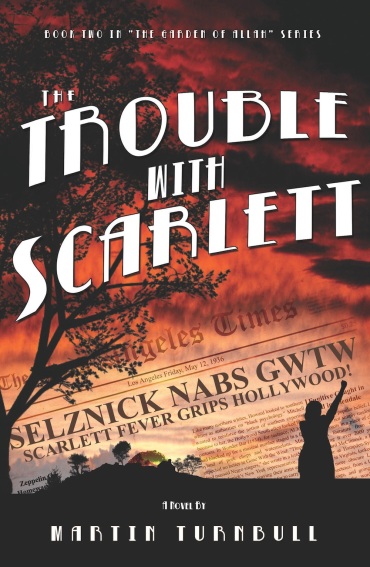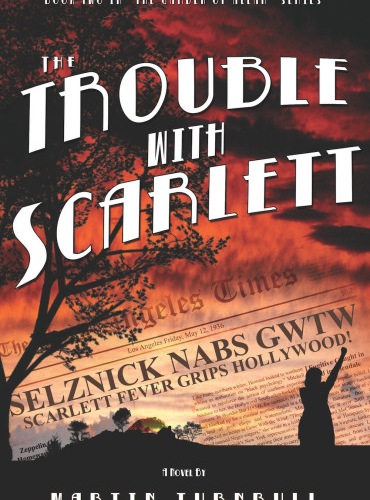Gone with the Wind
Review: “The Trouble with Scarlett” by Martin Turnbull
Book Reviews

Summer, 1936: Gone with the Wind is released by first-time author Margaret Mitchell and becomes an international sensation. Everyone in Hollywood knows that Civil War pictures don’t make a dime, but renegade movie producer David O. Selznick snaps up the movie rights and suddenly the talk around dinner tables and cocktail parties across the country is fixated on just one question: Who will win the role of Scarlett O’Hara?
When aspiring actress Gwendolyn Brick finally gets her hands on the book, it’s like the clouds have parted and the angels are singing the Hallelujah Chorus. Only a genuine southern belle can play Scarlett and didn’t she spend her childhood listening to Mama’s stories of Sherman’s march and all those damned Yankees? After years of slinging cigarettes at the Cocoanut Grove nightclub, Gwendolyn finds a new purpose in life: to become the silver screen’s Scarlett O’Hara. But isn’t that the ambition of every other pretty Hollywood gal with a deep-fried accent? She knows she’s going to have to stand out bigger than a hoop skirt at a Twelve Oaks barbecue.
Marcus Adler finds himself the golden boy of Cosmopolitan Pictures, the vanity production company set up by William Randolph Hearst for his movie star mistress, Marion Davies. He’s written Return to Sender, Davies’ first-ever genuine smash hit and wins a coveted invitation to spend the weekend at Hearst Castle. The kid who got kicked out of McKeesport, Pennsylvania, is now the guest of the richest man in America, rubbing shoulders with the likes of Myrna Loy, Winston Churchill, and Katharine Hepburn. But the trouble with flying high is that you have such a very long way to fall. When Marcus’ Hearst weekend turns into an unmitigated fiasco, Marcus finds himself sinking fast. He realizes he needs a new idea to impress the studios—real big and real soon—when the Garden of Allah hotel gains a new resident. F. Scott Fitzgerald arrives in Hollywood with a $1000-a-week contract at MGM but no idea how to write a screenplay. “Pleased to meetcha,” Marcus tells him. “We need to talk.”
When Selznick gives the nod to MGM’s George Cukor to direct Gone with the Wind, it’s the scoop of the year and falls into the lap of Kathryn Massey, the Hollywood Reporter’s newest columnist. But dare she publish it? All scoops are the exclusive domain of the Hearst papers’ all-powerful, all-knowing, all-bitchy Louella Parsons. Nobody in Hollywood has dared to outscoop Louella before, but isn’t it about time someone did? When Kathryn plunges ahead with her story, Louella retaliates low and dirty. Kathryn’s boss loses his nerve and leaves her dangling like a limp scarecrow in a summer storm. Then the telephone rings. It’s Ida Koverman, Louis B. Mayer’s personal secretary, and she has a proposition she’d like to make.
—Synopsis courtesy of author’s website.

Review:
“The Trouble with Scarlett” by Martin Turnbull
Decadent. Delicious. Divine.
That sums up my thoughts my thoughts on Martin Turnbull’s scintillating sequel to The Garden on Sunset. Full of wit, drama, humor and heart, readers fall in love with the characters in a dance through the Golden Age of Hollywood, specifically in the months and years leading up to the biggest film of the decade, Gone with the Wind.

Turnbull’s three main characters easily tell the story of this dramatic moment in motion picture history, gracefully dealing with issues like humiliation, rejection, and unrequited love that strike a chord with modern audiences.

The characters are funny and endearing, particularly Marcus himself. I personally enjoyed the screen test of Gwendolyn Brick the best, along with the antics that ensued during her pursuit of the role of Scarlett O’Hara herself.

What has won me over with this series is the insight into the film industry’s glory days, and the reimagining of famous legends (i.e. Vivien Leigh’s unexpected on-set appearance during the burning of Atlanta, the termination of George Cukor as director, etc.)

The novel daringly names names, and delves deeply into the private lives of our favorite stars on the silver screen.

The sexual content of The Trouble with Scarlett was toned down considerably compared to its predecessor, and lets the reader focus more on individual character development instead.

The dramatic jumps that occur from the end of one chapter to the beginning of the next one can be a bit confusing when a cliffhanger scene is sometimes ended too soon, and it takes a while to find out what happened after the end of a particular scene. This is sometimes the case when dealing with multiple narrators in alternating chapters, but like in my review of The Garden on Sunset, I still believe a chapter preface of the month/year (i.e. June 1939) would help the reader with following the timeline.

Martin Turnbull is a delightful author to read, and I feel his voice is genuinely captured in the prose of his Garden of Allah novels. His writing contains a precious commodity: in the commercial publishing market where an author’s individual voice is lost in the muddle of multi-million-dollar book deals, (Ahem, I’m talking to you, James Patterson!) Turnbull’s voice rings clear and true.

The Trouble with Scarlett is a gem, and a wonderful, rich tale of the bygone days of Tinseltown. Readers will certainly have no “trouble” reaching for the next book in the series, Citizen Hollywood.

Want to read Book One?

Download the The Garden on Sunset for FREE across all e-reader platforms here!
In accordance with FTC guidelines, the writers and editors of Shylock and Shakespeare and its affiliates receive no material or monetary compensation for reviews posted on this website or any social media platforms. All reviews are posted as personal reflections on said titles, and as such do not necessarily reflect the individual views and opinions of the original authors.
Review: The Garden on Sunset by Martin Turnbull
Book Reviews, Book ReviewsReview: The Garden on Sunset by Martin Turnbull

Synopsis:
In 1927, violet-eyed Alla Nazimova, the highest paid and most famous actress in the world, converted her Sunset Boulevard movie-star mansion into a hotel and dubbed it ‘The Garden of Allah.’ Before you could say Prohibition-Schmohibition it became a fabled residence-of-choice for hopeful and ambitious arrivals in Hollywood. The likes of Tallulah Bankhead, Robert Benchley, Dorothy Parker, Bogart & Bacall, Gary Cooper, F. Scott Fitzgerald, Errol Flynn, Harpo Marx, Orson Welles, and others walked, wobbled, wandered, and wafted through its doors and sometimes into its pool. Drunk. Or naked. Or both. And rarely alone.
Drawn to this hallowed haven is Marcus Adler whose own father has run him out of Pennsylvania. There is only one address he knows: 8152 Sunset Boulevard, Hollywood–the home of the luminous Nazimova, a vision in diaphanous lavender tulle who once visited him when he was a child sick with diphtheria. “Come visit me any time,” she whispered into his ear. He takes her at her word but finds her home is now a hotel. With nowhere else to go, he checks in and thinks, Now what? There he meets Kathryn Massey who has run away from her overbearing stage mother to pursue a career as a journalist–God forbid a girl in Hollywood would actually want to use her brains–and Gwendolyn Brick, a hopeful actress from ‘The Other Hollywood’–Hollywood, Florida–who has come to try her luck in Glitter City. The girl is blessed/cursed with a pair of lips that the men in this town are going to be lining up to have a go at. She won’t be able to fight them off on her own.
They band together: three naïve hopefuls madly dog-paddling against a tidal wave of threadbare casting couches, nervous bootleggers, human billboards, round-world Zeppelins, sinking gambling boats, waiters in black face, William Randolph Hearst, the Long Beach earthquake, starlets, harlots, Harlows and Garbos.
THE GARDEN ON SUNSET is the first in Martin Turnbull’s series of historical novels set during Hollywood’s golden age.
Synopsis Courtesy of the Author’s Website.
After coming off a recent reading high after finishing “Love Me” by Rachel Shukert, (review coming soon) I found the perfect solution in “The Garden on Sunset” by Martin Turnbull, book 1 in the Garden of Allah series. This self-published novel was pretty hard to track down, but eventually my library found just one copy in a library in Illinois and sent it my way.
Needless to say, I eagerly devoured this unknown gem in a few short days. It had everything I wanted in a novel about the Golden Age of Hollywood: exotic film stars, intrigue, and excellent descriptions of locales that were familiar to me via other books and movies like Schwabb’s, the Brown Derby, and the Paramount lot. Although some of the content was surprising, it fit very naturally in this plot, and I’m left wondering why this book hasn’t found a home with a traditional publishing house.
My only criticism would be about the timeline and pacing. As a reader, I was not sure if the plot had jumped forward a day, two days, a month or six months with each chapter. A little more time could have been taken for character development and I believe a little subscript at the top of the new chapters like “Six weeks later” or “Christmas, 1934” might have helped to keep readers a bit more oriented with the timeline.
For fans of the Starstruck series by Rachel Shukert, although definitely intended for an older reader, this series surely has the ability to go further in the publishing industry with some well-placed publicity.
Book 2: The Trouble With Scarlett

About the Author:

Martin Turnbull has worked as a private tour guide showing both locals and out-of-towners the movie studios, Beverly Hills mansions, Hollywood hills vistas and where all the bodies are buried. For nine years, he has also volunteered as an historical walking tour docent with the Los Angeles Conservancy. He worked for a summer as a guide at the Warner Bros. movie studios in Burbank showing movie fans through the sound stages where Bogie and Bacall, Bette Davis, Errol Flynn, and James Cagney created some of Hollywood’s classic motion pictures.
From an early age, Martin was enchanted with old movies from Hollywood’s golden era–from the dawn of the talkies in the late 1920s to the dusk of the studio system in the late 1950s–and has spent many, many a happy hour watching the likes of Garland, Gable, Crawford, Garbo, Grant, Miller, Kelly, Astaire, Rogers, Turner, Welles go through their paces.
When he discovered the wonderful world of biographies, autobiographies, and memoirs, his love of reading merged with his love of movies and his love of history to produce a three-headed hydra gobbling up everything in his path. Ever since then, he’s been on a mission to learn and share as much as he can about this unique time.
Originally from Melbourne, Australia, Martin moved to Los Angeles in the mid-90s.
Author Website: http://martinturnbull.wordpress.com/
Twitter: @TurnbullMartin



























